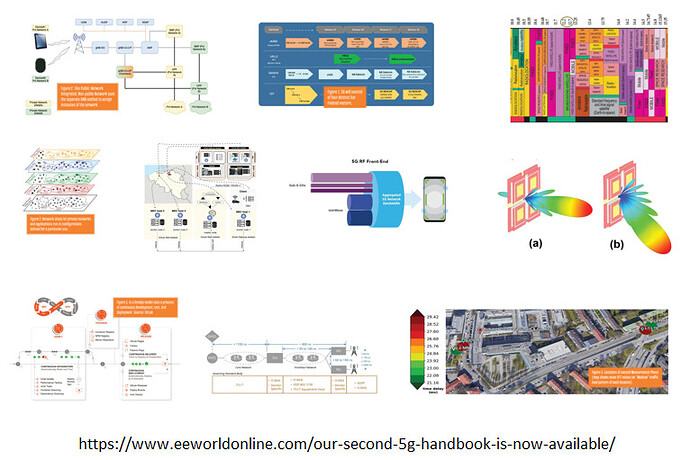Hello Experts.
I would like to recommend this great Handbook on 5G from EE World
Below you can see their introduction:
Featuring 15 articles, the 2022 5G Handbook looks at private networks, timing, connectivity, latency, mmWaves, test, and other topics.
Welcome to EE World’s 2022 5G Handbook. We gathered a new collection of articles, some 15 in total. The articles in this year’s handbook look at 5G across hardware and software. If you’re an IoT device designer that needs to connect to a private 5G network, you’ve come to the right place. If you’re a network engineer, we’ve got plenty for you, too. Click on the cover to read the handbook online or download your PDF copy.
Our call for articles included a list of some fifty suggested topics. To our surprise, several contributors chose to cover private networks. Those responses served as a wake-up call.
If you’d like to read individual articles online simply click on their titles. At the time that this went live, most articles are available. We’ve been posting them weekly. So, if you click on a title and go to the home page, come back and try again or read the complete handbook online or offline. All articles will be online as of June 3.
Private 5G: What is it? How does it work? covers the basics of private networks. Customize private 5G networks for application requirements shows you how to create a private network that fits specific needs.
You may think of private networks as mostly software adaptations of public networks, but there are plenty of physical aspects to consider. Optimize RF signals in private networks discusses how factory walls and objects interfere with 5G signals.
Small IoT devices that connect to public and private networks don’t need 5G’s full capabilities. How RedCap fits into 5G and IoT explains how RedCap devices support data rates of 85 Mb/sec, a performance grade serving a wide range of industrial and IoT use cases.
IoT devices need antennas. That’s where 5G Reshapes mobile RF design strategies comes in to explain how mmWave signals call for new RF design skills. Those radios also depend on power amplifiers. How DPD improves power amplifier efficiency tells you what radios do to reduce their carbon footprint.
5G’s mmWave requires test engineers to think differently about production test. Integration forces test engineers to develop over-the air tests at these frequencies. That includes smartphones in Mitigate mmWave test costs in 5G smartphones.” We also explore how to test Open RAN components in Open RAN rewrites network-testing rules.
Between the two current 5G frequency ranges you’ll find 12 GHz, which could add to 5G’s long list of frequencies. 5G demands for 12 GHz spectrum call for consensus on testing looks at what might be the future of 5G radios and tests.
Networks need software, lots of it. Network automation takes the work out of upgrades and Orchestration at the edge reduces network latency” get into how software operates those networks.
We’ve heard much about 5G’s reduced latency compared with LTE, but is it all hype? Where’s the data? Now, we have Measurements show 5G improves latency in public networks to show the improvement, which depends on traffic flow.
For the second year, we have two articles on network timing. How timing design and management synchronizes 5G networks and Synchronizing 5G networks brings timing challenges cover different aspects of network timing.
Finally, we take a look at powering small cells in Battery backup chemistries for 5G small-cell sites.
5G continues to evolve, with enhancements recently specified and more in development. Those standards will produce myriad of products, both for radios, networks, and IoT devices. Stay with EE World for the latest development and design techniques.
Source (and Download):
